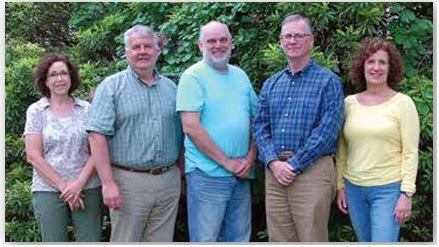The subject area being referenced is three separate parcels of land owned by two separate parties (one party owns 2 of the parcels). It is located behind Blockbuster Video along Commerce Drive. There are currently two single family homes on the subject area, one of which I understand is occupied, and one of which is currently not as the owner decided not to continue renting it to tenants in anticipation of the property's development. They share a common driveway and access via a paper street (Old Mill Rd) between Blockbuster Video and the FarMill River onto Bridgeport Ave. (Note: A paper street is one that exists on paper legally as a city street yet not commonly used as such. Usually they are unimproved paths from long ago.) The subject area is adjacent to land preserved by the Shelton Land Conservation Trust both to the upstream and downstream boundaries, and the Far Mill River on the northern boundary. The Far Mill River is a Greenway corridor identified on the City of Shelton's Open Space Plan for special attention toward open space preservation.
A developer approached the owners of the three parcels, negotiated and obtained an option agreement (typically a private and exclusive agreement to purchase the property at a future date once application approvals are obtained), and then applied to the Planning and Zoning Commission toward his goal.
The development proposal was 2 concurrent applications under the PDD (Planned Development District) mechanism, a method that has come under increased scrutiny by the community, especially when used for residential development. PDD's are unique unto each one approved in respect to what it outlines. (The PDD for Shelton Square is different than the PDD of R.D. Scinto's Enterprise Park for example). Because of this zone designation's individualistic nature and the inability of adjacent property owners to have an expectation as to the outcome of such a zone mechanism that could dramatically affect their property values, a PDD can only occur in areas that our outlined as "Special Development Areas" or SDA's. An SDA is an overlay on the zoning map and not a change to the underlying zoning. Thus in this case, there was an application to apply an SDA to the subject area, and a second application, concurrently, to apply a PDD with it's specific proposition to the proposed SDA.
I have personally said many times before that such concurrent applications should not be accepted. There is an assumption with the PDD application that there will be an approval for an SDA. This is a mixing of planning and development proposals. Planning should occur with holistic thinking of impact on the municipality, it should not occur as an outcome of a proposal for development. Planning should be preperatory, not reactionary.
The Conservation Commission gives commentary on applications for development, and you can read it for this application via this hyperlink.
Rather than a hyperlink to the CtPost article which may not work in the future, I show it here along with my commentary in red:
+++++++++
City criticized for failing to buy riverfront land
KATE RAMUNNI, Correspondent
SHELTON — Two Planning and Zoning Commission members say the city missed an important opportunity when it did not buy property along the Far Mill River that will now be developed into condominiums. I do not know of what "important opportunity to buy the property" the two members are referencing. The correspondent on this article reported on Jun14 in the CtPost the following: "The commission should determine how many units would be allowed on the property", Sylvester said, "so the fair market value can be set. Then the city should make an offer".
The commission this week approved Lava Real Estate's plans for condominiums off Bridgeport Avenue, behind Blockbuster Video. Initially the developer proposed building 16 units on the 2.5-acre site, but the commission reduced that number to 12. This approval required a zone overlay as a Special Development Area. It then required a zone change to a Planned Development District. All of those actions and approvals by the Planning & Zoning Commission are supposed to work in concert with the planning documents they have approved for the subject area such as the Rte 8 Corridor Study and the Plan of Conservation & Development. Both those planning documents identified this as an important area for preservation as open space. The PDD method gives the Planning & Zoning Commission great latitude and they could have approved only 8 units if they desired, or less or more. The ambiguity of the unknown and lack of consistency is what concerns the residents of Shelton in regard to use of the PDD regulations for development in town.
The application drew the objections of a number of residents who voiced fears that the development would add traffic, congestion and pollution to the area. Any development would add those elements to the area. The more appropriate question is would they be impacting to the area in such a degree that the proposal should not be approved. Apparently the Planning & Zoning Commission believes unanimously that the impacts of 12 units on this parcel don't rise to that level. I would disagree. I believe their own planning documents would disagree.
The city would have been better off buying the land, commissioners Leon J. Sylvester and Daniel Orazietti said. This past tense statement is directly in contrast to Mr. Sylvester's quote in the Jun14 CtPost where he projected the future in saying that the development should be approved with a determined unit count to help set the price of acquisition. That statement was the definition of prejudicing a vote. It needs to be said that the Conservation Commission has traditionally looked at open or natural landscape lands to acquire for City Open Space. This subject area had 2 separate property owners owning 3 separate parcels that had 2 separate resident dwelling units, both of which were recently occupied. As the community experiences more of these "tear-downs" for re-development resulting in loss of what is "perceived open space", especially with oversized lots, and in particular greenway corridors such as this, the Conservation Commission will have to consider them also as possible targets for acquisition toward City Open Space.
"I feel very strongly that this property should have been purchased by the city," Sylvester said. "It is a beautiful piece of property, and I think the city is making a big mistake letting it go."
"It is great open space. I don't understand what they are thinking," Orazietti said, referring to the Conservation Commission and the Board of Aldermen, both of which declined to pursue a purchase. The Conservation Commission gave a summary on this subject area, however I can not comment on discussions held in "executive session" but offer the following: as is typical for developers submitting applications, the property at the current time could not be "purchased" as the owners had exclusive option agreements with the developer/applicant. The owners are precluded from selling it to another party. The City does have the option to enact an eminent domain proceeding and "acquire" the property by siezing if for a stated public purpose.
"They had no interest in the property," Planning and Zoning Commission Chairman Allan J. Cribbins said. "Based on the recommendation of the Conservation Commission, the Board of Aldermen found it was not a priority," Zoning Administrator Rick Schultz said. "They are more interested in the larger parcels." The ConsComm didn't previous to the application have a "targeting" interest in acquiring these specific parcels. As previously mentioned we have traditionally been looking at parcels with natural landscape for open space acquisitions, not properties that are primarily homes or costly properties in commercial areas. That should not take away from the fact that we still have an interest in the Greenway corridor as an important area to preserve not only through acquisition of land by purchase, but via open space set-asides from subdivisions and conditions of approval for development. That has been stated in our Open Space Plan and the two afore mentioned planning documents of the Planning & Zoning Commission. The PDD mechanism undertaken by the developer allows great latitude by the Planning & Zoning Commisison in it's approval statement. It was the Planning & Zoning's unanimous decision as to the amount of development intensity approved as well as the amount of open space and the location of it within this development's application area. I can not comment as to what our letter said to the Board of Alderman regarding acquisition, but can publicly say that simply the size of a parcel, no matter where it is located in town, does not solely dictate the concern for it to become or remain as open space.
But it is the smaller pieces — and especially ones along a waterway — that need to be preserved, Sylvester charged. Mr. Sylvester can posture his comments, but he can't have it both ways. If his concern was to protect this area along the waterway, then he should not have voted for the development as approved. Instead, he should have made the claim as to the amount of open space that should be required for this PDD zone referencing the Open Space Plan and the application's location in the identified Far Mill River Greenway, his Commission's Rte8 Corridor Study, and the recently adopted Plan of Conservation and Development.
Lava Real Estate's property is bordered by open space owned by the Shelton Land Trust.
"We need to have a lot more recognition of the importance of land along the waterways," Sylvester said, adding that he does not believe such properties are adequately addressed in the city's Plan of Development. "This is a perfect example of why people feel things are getting overdeveloped — we take this pristine piece of property and allow it to be developed, and we are missing the boat here." I don't know how Mr. Sylvestor defines pristine, but it does make a good sound bite to a reporter and panders to a large audience that was in attendance that night. I don't want to diminish the value of conserving the character of the land in this area, but to say that an area of properties with 2 homes and a barn behind a Blockbuster Video is "pristine" is a mis-characterization. There is no question that it is a pretty spot. It is in a greenway corridor. It is riverfront property and the City Engineer's issued a negative letter given the proximity to the 100yr flood plain area. The Inland Wetlands Commission has not yet given an opinion on the concept either. All this raises the question that if it is so important to conserve open space on this area, why did the Planning & Zoning Commission vote unanimously to approve the application?
"Here is another lost opportunity," said Nancy Steiner, a member of the citizens group We R-1. "The people of Shelton spoke about the need to preserve this open space, and here the commission had a choice and didn't do it. It is very, very disappointing to think that these boards and commissions hear what the people say and don't act on it." Such public sentiment does not fall on deaf ears at the Conservation Commission. All members of boards and commissions that make these decisions need to be held more accountable for their actions or lack there-of. Reporting of these events is unfortunately not as thorough as could be conducted. I sleep peacefully knowing that there is no member of the Conservation Commission hearing applications involving former co-workers and earning family income off residential development and building in Shelton.
++++++++++++++



2 comments:
Post a Comment